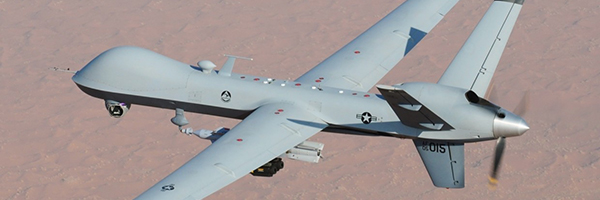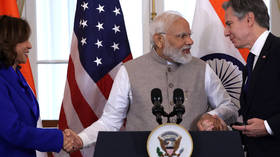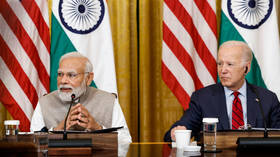US Predator drone deal: does it really benefit India?
 Joydeep Sen Gupta, RT, July 1, 2023 —
Joydeep Sen Gupta, RT, July 1, 2023 —
India’s bid to acquire 31 MQ-9B Predator drones from the US has triggered a raging controversy over the big-ticket defense procurement. The main opposition Congress party has questioned the deal, announced during Indian Prime Minister Narendra Modi’s recent State visit to the US, over its high cost and a “lack of transparency.”
To be sure, India is the only non-NATO country and non-US ally slated to possibly get the drones.
What is the Predator drone deal?
On June 15 the Defense Acquisition Council (DAC), headed by Defense Minister Rajnath Singh, approved the acquisition of 31 MQ-9B drones from the US through the foreign military sale route.
The contours of the deal were finalized by Singh during the visit of US Defense Secretary Lloyd Austin last month. According to the MoD statement, the estimated cost of the drones is approximately $3.1 billion. The Modi administration has maintained that this is an indicative price and a final figure will be arrived at after further negotiations.
How will India use the MQ-9B drones?
India is likely to receive the first 10 Predator drones, manufactured by San Diego-based defense manufacturer General Atomics, within two years after the final agreement is signed – a lengthy process –and the remaining 21 are to be supplied in batches every six months.
Under the deal, the Indian Navy is supposed to receive 15 MQ-9B Sea Guardians, while the Army and the Air Force will get eight Sky Guardians each. Both are variants of the famous Predator. The drones will be deployed in three major hubs across the northern, northeastern, and southern parts of India, helping the armed forces to keep an eye on adversaries during both peace and war, according to defense authorities.
One of the hubs to be developed is at the Indian Navy’s air station, INS Rajali, at Arakkonam in Tamil Nadu in south India, where two Predator drones, which were leased in November 2020, are already operating. These drones can fly for up to 40 hours at an altitude of over 40,000 feet for surveillance missions, and are armed with Hellfire air-to-ground missiles and smart bombs for precision strikes. Two of these drones – considered far superior to Chinese models – were leased from the US after the Indian Army lost 20 of its personnel in violent border clashes with China’s People’s Liberation Army (PLA) in the eastern Ladakh region in May 2020.
The defense ministry is planning to deploy 16 Predator drones for land and aerial surveillance on both the western and eastern fronts to keep India’s nuclear-armed hostile neighbors, Pakistan and China, at bay. An additional 16 Predator drones will be deployed to maintain surveillance over India’s island territories and maritime zones in the Indian Ocean Region. The Predators will be operated by the joint command of the three armed services, and the purchase will serve as a template for similar acquisitions in the future as well, the authorities added.
Indian Navy chief Admiral Radhakrishnan Hari Kumar has welcomed the government’s move to acquire Predator drones from the US. In an exclusive to India Today, he said the maritime version of the drone could be “utilized to improve surveillance and increase maritime domain awareness.”
“In peacetime, we conduct ISR missions, which involve intelligence, surveillance, and reconnaissance. However, in times of crisis or combat situations, these drones possess the potential to be utilized for detecting, tracking, and even targeting,” he added.
What is the acquisition process?
An ‘acceptance of necessity,’ which was provided by the DAC, is the first step in the procurement process. New Delhi is now required to issue a ‘letter of request’ to the Biden administration and will await a ‘letter of offer and acceptance’ from the US government, following approval by the US Congress. Subsequently, the Contract Negotiation Committee will finalize the terms of agreement before it is approved by the Cabinet Committee for Security (CCS). The actual price and terms of the contract will be known after these processes are completed.
The government is hoping that the procurement will come with a certain percentage of localization, in a bid to jointly manufacture the drones in India. New Delhi is aiming for a figure of at least 20% indigenous content, according to MoD sources. The acquisition does not run counter to Modi’s “Make in India” program, as the state-run Defense Research and Development Organization (DRDO) is simultaneously developing Tapas, a drone in the Medium Altitude Long Endurance (MALE) category.
What are the opposition’s objections?
Pawan Khera, the Congress party spokesperson, has questioned the government over the cost of the potential purchase. “Why is India paying more than the price for a drone, as compared to other countries? Why are we paying the “highest price” for a drone, which does not have AI (artificial intelligence) integration?” he asked.
He said that each Predator drone would cost approximately $110 million, and with Modi aiming to buy 31, the final cost would be $3 billion. Meanwhile, Khera claimed the DRDO could develop the same thing at a much lower cost. In his estimation, the price tag could be as low as 20% of the amount to be paid to the US.
The Congress spokesperson cited data to bolster his party’s argument. “The US Air Force bought the MQ-9 drone, which is a superior quality version, at $56.5 million per drone, while the UK Air Force bought the MQ-9B drone at $12.5 million per drone in 2016.”
According to him, the Australian government was supposed to buy the same drones at approximately $137 million each, but later canceled citing high costs. Spain also acquired the MQ-9s for about $47 million and Taiwan for $54 million per aircraft. Italy and the Netherlands paid $82 million per drone and Germany got them for only $17 million a piece. “But the Modi government is making India pay $110 million per drone – the most expensive buy for any country,” Khera stated.
The Congress party has previously raked up controversy surrounding the acquisition of French Rafale twin-engine multi-role fighter jets. Talks on the purchase of 126 jets were initiated in 2008, when the United Progressive Alliance (UPA) coalition was in power, but the deal never came through.
The Modi government went ahead with the jet deal after it came to power, albeit with some major revisions, including the quantity and cost of the purchase. In 2016, it signed a $8.59 billion deal with France for 36 Rafale jets. The controversy arose concerning a more than 100% increase in the price of each aircraft. The Congress party’s AK Antony, who was the defense minister in 2008 when India and France inked an inter-governmental agreement on the procurement, said the Modi administration’s claim that the secrecy clause was forcing it not to reveal the price details of the deal was “totally wrong.”
What is the government’s counterargument?
On June 25, the government put out a strong rebuttal to the opposition’s criticism of the Predator drone deal. The MoD explicitly stated that it would compare the acquisition cost with the best price offered by the manufacturer to other countries.
The ministry insisted that “price and other terms and conditions of the purchase are yet to be finalized and subject to negotiations,” and urged critics “not to spread fake news/misinformation which can have serious impact on the morale of the Armed Forces and adversely impact the acquisition process.”
Meanwhile, a senior government official told PTI news agency on Thursday that the Predator drone price offered by the US was 27% lower than charged to other countries and negotiations could bring it further down. He said that currently each drone would cost $99 million, while the UAE, which is one of the few countries to possess the platform, paid $161 million a piece. The official explained that India is looking to acquire a similar drone to that of the UAE, but with a better configuration.
He noted that 16 of the drones purchased by the UK had cost $69 million each but that the model was only a “green aircraft” without sensors, weapons and certification. “Features like censors, weapons and payloads make up for up to 70% of the total cost and even the US acquired five of them at $119 million each,” he added. The official sounded a word of caution and did not rule out an upwards price revision because “India may need to integrate some of its own radars and missiles with these drones.”


